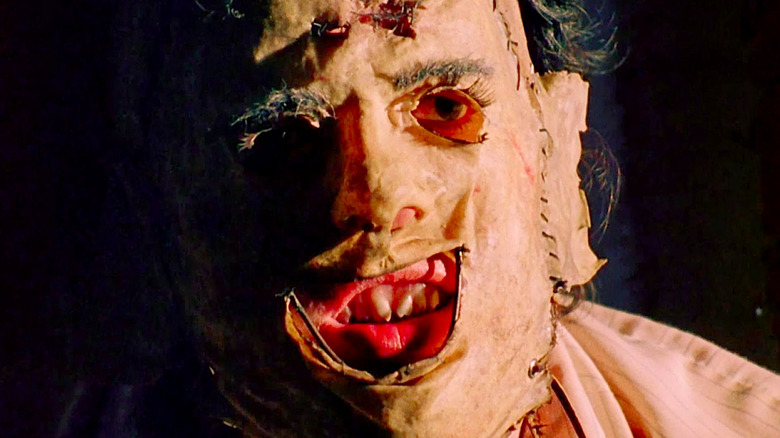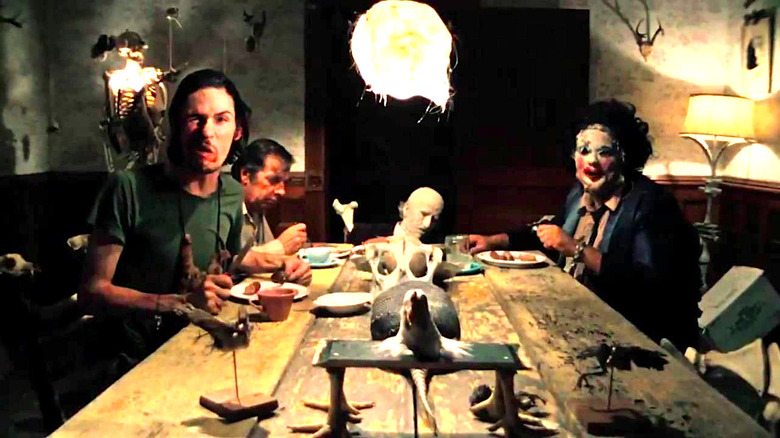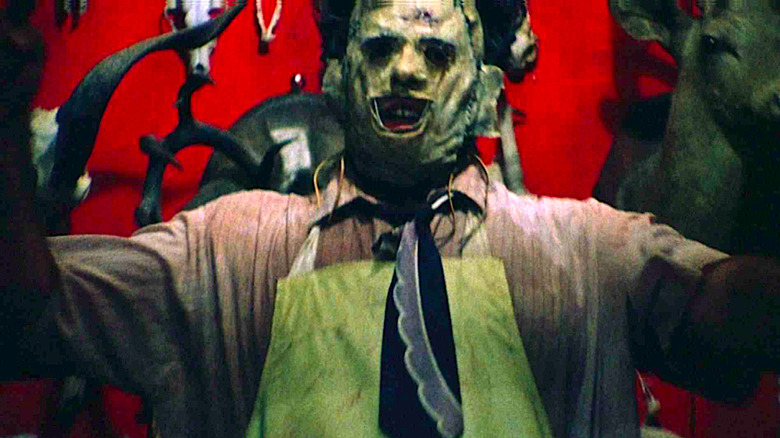Tobe Hooper's Idea For Leatherface's Mask Actually Came From Greek Tragedy
There's a lot to be said about Tobe Hooper's 1974 horror film "The Texas Chain Saw Massacre." It is a movie well worth taking the time to unpack, paying close attention to its not-so-subtle commentary on 1970s politics. There are, of course, many people who dislike it, finding it too raw and disturbing to ever be considered a work of art. And yet a copy of the film exists in the Museum of Modern Art's permanent collection, and it appears on pretty much every list of the best horror movies ever made. It has even been inducted into the Horror Hall of Fame (RIP), and it's gone on to amass an impressive collection of awards honoring its brilliance.
Many people have tried to compare its unique style to other forms of storytelling like ballet — that final scene with Leatherface and his chainsaw is so often referred to as "a dance" — and even Greek theater. Horror historian Leonard Wolf has compared the film to both, making sure to draw attention to the fact that "all the violence is offstage." In other words, what makes "The Texas Chain Saw Massacre" so effective is not any kind of particular reliance on violence and gore, but rather the atmosphere it creates with its visual language.
One of the film's most effective visuals comes in the form of Leatherface's mask. Designed to mimic the look of skinned human flesh, Leatherface is never seen without it. The mask is as essential to his personality as his chainsaw, and for Hooper, the costuming decision is directly rooted in the Greek tragedy so many people see reflected in the film as a whole.
The horror of Greek theater masks
Mask-wearing was prevalent in traditional Greek theater. Typically, they were meant to allow for easier audience visibility and to help people distinguish characters from one another. Made of stiffened linens, the masks also had large eye and mouth holes to allow for clearer expression and enunciation on stage. Because every character was represented by a mask, actors were able to portray multiple people within the same play. It's well known that Greek plays were put on by an all-male cast, so the masks were an easy way to allow the actors to take on female roles within their productions. In many ways, the mask was essential to the art form, giving the actors the freedom necessary to portray their roles with confidence.
Leatherface's image is such an essential part of his character that it is hard to ignore the potential for symbolism behind his specific mask. Tobe Hooper was asked to explain where the concept of the character's face came from for Interview Magazine:
"It really came from Greek tragedy as a foundation. But it was just something I felt the character would do. It isn't that he's hiding anything."
The mask becomes a way for us to interpret Leatherface and his complex, tortured psyche. It has three versions in "The Texas Chain Saw Massacre." The first is his classic killing mask made of sewn-together human skin, and it is the one he wears for the majority of the film's first act. The second iteration is done up with gaudy makeup put on, presumably, by Leatherface, and it is worn, along with a wig, for most of the film's second act. The third, which looks like an old lady, is often forgotten about since it appears only briefly when The Cook and Hitchhiker return to the house with Sally ("Look what your brother did to the door!"). Just like in Greek theater, all three masks greatly contribute to how Leatherface's character can be interpreted.
Getting to know the man behind the mask
Leatherface's mask, much like its Greek counterparts, resembles stiffened fabric or cloth. It has a sinewy look that is probably similar to what "stiffened linen" looked like to the Greeks. The only difference is Leatherface uses human skin to craft his version. He also mimics Greek tradition by putting on makeup over the mask to wear to the film's infamous dinner scene. Greek theater masks were typically painted on to give the faces distinct personalities.
The most interesting comparison, though, is that of character recognition. While it is very doubtful that Leatherface has any idea what Greek theater even is, he does seem to choose his masks based on the role he wants to play within the family household. Two out of the three masks depict him as a domesticated wife/mother or grandmother, intent on cooking for and taking care of the family, while the killing mask is worn during his "work hours," when he is butchering animals for the family business.
If we interpret the old lady mask and pretty woman mask as symbols of domesticity (as many have), we can begin to view Leatherface's actions as more than just a desire to kill. In fact, I would argue his murderous rampage is born out of fear and a desire to protect rather than anything else. It's almost as if a motherly instinct to shield her young kicks in, causing him to become hellbent on capturing and killing Sally and her friends, who he wrongfully perceives as threatening. Tobe Hooper told Interview Magazine that Leatherface is clearly perplexed by the arrival of Sally and her friends, and that he knows he shouldn't be killing them, but his fear is what drives him. Interpreting Leatherface in this way, his masks — which are all, admittedly, very frightening — become symbolic of his own inner fears and desires, humanizing him rather than turning him into nothing more than a cold-blooded killer.


